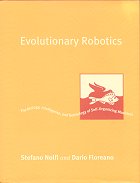Contents
- • Hans Meinhardt. From Fertilized Eggs to Complex Organisms: Models of Biological Pattern Formation. 1999
- • William D. Hamilton. Fables of Cyberspace: Tapeworms, Horses, and Mountains. 1999
- • Luc Steels. Cognitive Teleportation and Situated Embodiment. 1999
- • Tim Lenton. Testing Gaia Theory with Artificial Life. 1999
- • Edmund M. A. Ronald, Moshe Sipper, Mathieu S. Capcarrere. Testing for Emergence in Artificial Life. 1999
- • Paul Domjan. Are Romance Novels Really Alive? A Discussion of the Supple Adaptation View of Life. 1999
- • Richard A. Watson, Jordan B. Pollack. How Symbiosis Can Guide Evolution. 1999
- • Yuka Yamamoto, Takahiro Sasaki, Mario Tokoro. Adaptability of Darwinian and Lamarckian Populations Toward an Unknown New World. 1999
- • Tsutomu Oohashi, Tadao Maekawa, Osamu Ueno, Emi Nishina, Norie Kawai. Requirements for Immortal ALife to Exterminate Mortal ALife in One Finite, Heterogeneous Ecosystem. 1999
- • Gabriela Ochoa, Inman Harvey, Hilary Buxton. Error Thresholds and Their Relation to Optimal Mutation Rates. 1999
- • Seth Bullock. Are Artificial Mutation Biases Unnatural?. 1999
- • Stevan Jay Anastasoff. Evolving Mutation Rates for the Self-Optimisation of Genetic Algorithms. 1999
- • Sevan G. Ficici, Jordan B. Pollack. Statistical Reasoning Strategies in the Pursuit and Evasion Domain . 1999
- • Atsuko Mutoh, Satoru Oono, Kousuke Moriwaki, Tsuyoshi Nakamura, Nobuhiro Inuzuka, Hidenori Itoh. An Evolutionary Method Using Crossover in a Food Chain Simulation. 1999
- • Tim Taylor. On Self-Reproduction and Evolvability. 1999
- • Russell K. Standish. Some Techniques for the Measurement of Complexity in Tierra. 1999
- • Andreas Rechtsteiner, Mark A. Bedau. A Generic Neutral Model for Quantitative Comparison of Genotypic Evolutionary Activity. 1999
- • Henning Schwobbermeyer, Jan T. Kim. A Comparative Analysis of Biodiversity Measures. 1999
- • Charles Ofria, Christoph Adami, Travis C. Collier, Grace K. Hsu. Evolution of Differentiated Expression Patterns in Digital Organisms. 1999
- • Arno Rasek, Walter Doerwald, Michael Hauhs, Alois Kastner-Maresch. Species Formation in Evolving Finite State Machines. 1999
- • Michael O'Neill, Conor Ryan. Genetic Code Degeneracy: Implications for Grammatical Evolution and Beyond. 1999
- • Josh C. Bongard. Coevolutionary Dynamics of a Multi-population Genetic Programming System. 1999
- • Vesselin Vassilev, Julian F. Miller, Terence C. Fogarty. The Evolution of Computation in Co-evolving Demes of Non-uniform Cellular Automata for Global Synchronisation. 1999
- • Stefano Nolfi, Domenico Parisi. Exploiting the Power of Sensory-Motor Coordination. 1999
- • Dario Floreano, Joseba Urzelai. Evolution of Neural Controllers with Adaptive Synapses and Compact Genetic Encoding. 1999
- • Auke Jan Ijspeert. Synthetic Approaches to Neurobiology: Review and Case Study in the Control of Anguiliform Locomotion. 1999
- • Richard Walker, Orazio Miglino. Replicating Experiments in "Detour Behavior" with Artificially Evolved Robots: An A-Life Approach to Comparative Psychology. 1999
- • Rens Kortmann, John Hallam. Studying Animals through Artificial Evolution: The Cricket Case . 1999
- • Anil K. Seth. Evolving Behavioural Choice: An Investigation of Herrnstein's Matching Law. 1999
- • John Albert. Modeling of an Early Evolutionary Stage of the Cnidarian Nervous System and Behavior. 1999
- • Ranit Aharonov-Barki, Tuvik Beker, Eytan Ruppin. Spontaneous Evolution of Command Neurons, Place Cells and Memory Mechanisms in Autonomous Agents. 1999
- • Adam Rotaru-Varga. Modularity in Evolved Artificial Neural Networks. 1999
- • Maciej Komosinski, Szymon Ulatowski. Framsticks: Towards a Simulation of a Nature-Like World, Creatures and Evolution. 1999
- • Tony Belpaeme. Evolving Visual Feature Detectors. 1999
- • Seiji Yamada. Evolutionary Design of Mobile Robot Behaviors for Action-Based Environment Modeling. 1999
- • Jun Tani, Yuya Sugita. On the Dynamics of Robot Exploration Learning. 1999
- • Ian Kelly, Owen E. Holland, Martin Scull, David J. McFarland. Artificial Autonomy in the Natural World: Building a Robot Predator. 1999
- • Yasuhisa Hasegawa, Yoshikuni Ito, Toshio Fukuda. Behavior Adaptation on Behavior-Based Controller for Brachiation Robot. 1999
- • Andrew Adamatzky, Owen E. Holland, Nicholas G. Rambidi, Alan F. T. Winfield. Wet Artificial Brains: Towards the Chemical Control of Robot Motion by Reaction-Diffusion and Excitable Media. 1999
- • Sorin Moga, Philippe Gaussier. A Neuronal Structure for Learning by Imitation. 1999
- • Mathias Quoy, Philippe Gaussier, Sacha Lepretre, Arnaud Revel. A Neural Model for the Visual Navigation and Planning of a Mobile Robot. 1999
- • J. A. Becerra, J. Santos, R. J. Duro. Progressive Construction of Compound Behavior Controllers for Autonomous Robots Using Temporal Information. 1999
- • Axel Loffler, Jurgen Klahold, Manfred Hussman, Ulrich Ruckert. A Visualization Tool for the Mini-Robot Khepera: Behavior Analysis and Optimization. 1999
- • Thomas Netter, Nicolas Franceschini. Towards UAV Nap-of-the-Earth Flight Using Optical Flow. 1999
- • Tom Quick, Kerstin Dautenhahn, Chrystopher L. Nehaniv, Graham Roberts. On Bots and Bacteria: Ontology Independent Embodiment. 1999
- • Daniel Thalmann. Populating the Virtual Worlds with Interactive Perceptive Virtual Actors. 1999
- • Soraia Raupp Musse,, Marcelo Kallmann, Daniel Thalmann. Level of Autonomy for Virtual Human Agents. 1999
- • Aapo Hyvarinen, Timo Honkela. Emotional Disorders in Autonomous Agents?. 1999
- • Mark Witkowski. Integrating Unsupervised Learning, Motivation and Action Selection in an A-Life Agent. 1999
- • George G. Szpiro. Can Computers Have Sentiments? The Case of Risk Aversion and Utility for Wealth. 1999
- • Daniel Mange. Towards Robust Bio-inspired Circuits: The Embryonics Approach. 1999
- • Kepa Ruiz-Mirazo, Alvaro Moreno, Federico Moran, J. J. Merelo. Designing a Simulation Model of a Self-Maintaining Cellular System. 1999
- • Hugues Bersini. Design Patterns for an Object-Oriented Computational Chemistry. 1999
- • Naoaki Ono, Takashi Ikegami. Model of Self-Replicating Cell Capable of Self-Maintenance. 1999
- • Oliver Sharpe. Evolution at the Origins of Life: Modelling Simple Persistent Replication Objects. 1999
- • Hideaki Suzuki. A Simulation of Life Using a Dynamic Core Memory Partitioned by Membrane Data. 1999
- • Claus O. Wilke, Christopher Ronnewinkel, Thomas Martinetz. Molecular Evolution in Time-Dependent Environments. 1999
- • Tomoyuki Yamamoto, Paulien Hogeweg. Evolution to Complexity: Replication, Elongation and Assembly in an RNA World. 1999
- • Kouji Harada, Takashi Ikegami. Evolution of Multispecificity in an Immune Network. 1999
- • Andrew Adamatzky, Owen E. Holland, Chris R. Melhuish. Laziness + Sensitivity + Mobility = Structure: Emergence of Patterns in Lattice Swarms. 1999
- • Cesar Ortega, Andy M. Tyrrell. Self-Repairing Multicellular Hardware: A Reliability Analysis. 1999
- • Enrico Petraglio, Jean-Marc Henry, Gianluca Tempesti. Arithmetic Operations on Self-Replicating Cellular Automata. 1999
- • Torsten Reil. Dynamics of Gene Expression in an Artificial Genome -- Implications for Biological and Artificial Ontogeny. 1999
- • Shugo Hamahashi, Hiroaki Kitano. Parameter Optimization in Hierarchical Structures. 1999
- • Koji Kyoda, Hiroaki Kitano. A Model of Axis Determination for the Drosophila Wing Disc. 1999
- • Mineo Morohashi, Hiroaki Kitano. Identifying Gene Regulatory Networks from Time Series Expression Data by in silico Sampling and Screening. 1999
- • Massimiliano Ugolini, Domenico Parisi. Simulating the Evolution of Artifacts. 1999
- • Martijn Brinkers, Paul den Dulk. The Evolution of Non-reciprocal Altruism. 1999
- • Ezequiel A. Di Paolo. A Little More than Kind and Less than Kin: The Unwarranted Use of Kin Selection in Spatial Models of Communication. 1999
- • Jason Noble, Elio Tuci, Peter M. Todd. An Evolutionary Simulation Model of Social Learning about Food by Norway Rats. 1999
- • Charlotte K. Hemelrijk. Effects of Cohesiveness on Inter-Sexual Dominance Relationships and Spatial Structure among Group-Living Virtual Entities. 1999
- • Seth Bullock, Jennifer Nerissa Davis, Peter M. Todd. Simplicity Rules the Roost: Exploring Birdbrain Parental Investment Heuristics. 1999
- • Takashi Ikegami, Makoto Taiji. Imitation and Cooperation in Coupled Dynamical Recognizers. 1999
- • Takashi Ishida, Hiroshi Yokoi, Yukinori Kakazu. Emergence of Adaptive Society with Competitive Selfish Agents. 1999
- • Eizo Akiyama, Kunihiko Kaneko. Dynamical Systems Game (The Lumberjacks' Dilemma Model). 1999
- • Yoshiki Yamaguchi, Tsutomu Maruyama, Tsutomu Hoshino. High Speed Hardware Computation of Co-evolution Models. 1999
- • Alcherio Martinoli, Auke Jan Ijspeert, Luca Maria Gambardella. A Probabilistic Model for Understanding and Comparing Collective Aggregation Mechanisms. 1999
- • Chris R. Melhuish. Exploiting Domain Physics: Using Stigmergy to Control Cluster Building with Real Robots. 1999
- • Aude Billard, Auke Jan Ijspeert, Alcherio Martinoli. Exploration of a Dynamic Environment by a Group of Communicating Robots. 1999
- • Jordi Delgado, Ricard V. Solé. Task Fulfilment and Temporal Patterns of Activity in Artificial Ant Colonies. 1999
- • Ann Nowe, Katja Verbeeck. Formalizing the Ant Algorithms in Terms of Reinforcement Learning. 1999
- • A. E. Langham, P. W. Grant. Using Competing Ant Colonies to Solve k-way Partitioning Problems with Foraging and Raiding Strategies. 1999
- • N. Monmarche, M. Slimane, Gilles Venturini. On Improving Clustering in Numerical Databases with Artificial Ants. 1999
- • Hidenori Kawamura, Masahito Yamamoto, Keiji Suzuki, Azuma Ohuchi. Ants War with Evolutive Pheromone Style Communication. 1999
- • Jason Noble. Sexual Signalling in an Artificial Population: When Does the Handicap Principle Work?. 1999
- • Angelo Cangelosi. Modeling the Evolution of Communication: From Stimulus Associations to Grounded Symbolic Associations. 1999
- • Bart de Boer, Paul Vogt. Emergence of Speech Sounds in Changing Populations. 1999
- • Ahmed-Reda Berrah, Rafael Laboissiere. SPECIES: An Evolutionary Model for the Emergence of Phonetic Structures in an Artificial Society of Speech Agents. 1999
- • Luc Steels, Frederic Kaplan. Collective Learning and Semiotic Dynamics. 1999
- • Edwin D. de Jong. Analyzing the Evolution of Communication from a Dynamical System's Perspective. 1999
- • Simon Kirby. Syntax out of Learning: The Cultural Evolution of Structured Communication in a Population of Induction Algorithms. 1999
- • Daniel Livingstone, Colin Fyfe. Modelling the Evolution of Linguistic Diversity. 1999
- • Tracy Teal, Daniel Albro, Edward Stabler, Charles E. Taylor. Compression and Adaptation. 1999
- • Christopher Dircks, Scott C. Stoness. Effective Lexicon Change in the Absence of Population Flux. 1999
- • Pierre-Yves Oudeyer. Self-Organization of a Lexicon in a Structured Society of Agents. 1999
- • Takashi Hashimoto. Modeling Categorization Dynamics through Conversation by Constructive Approach. 1999





